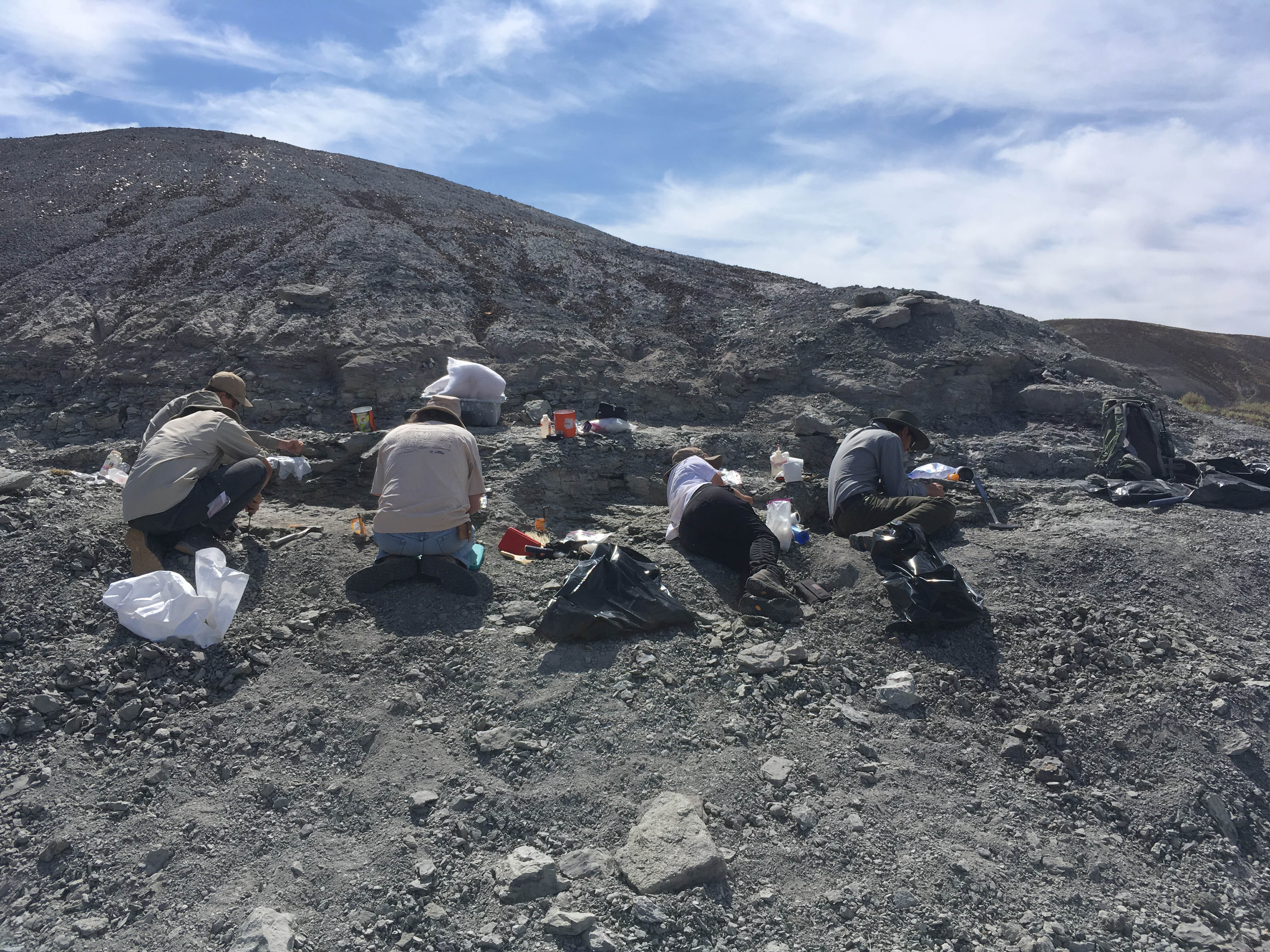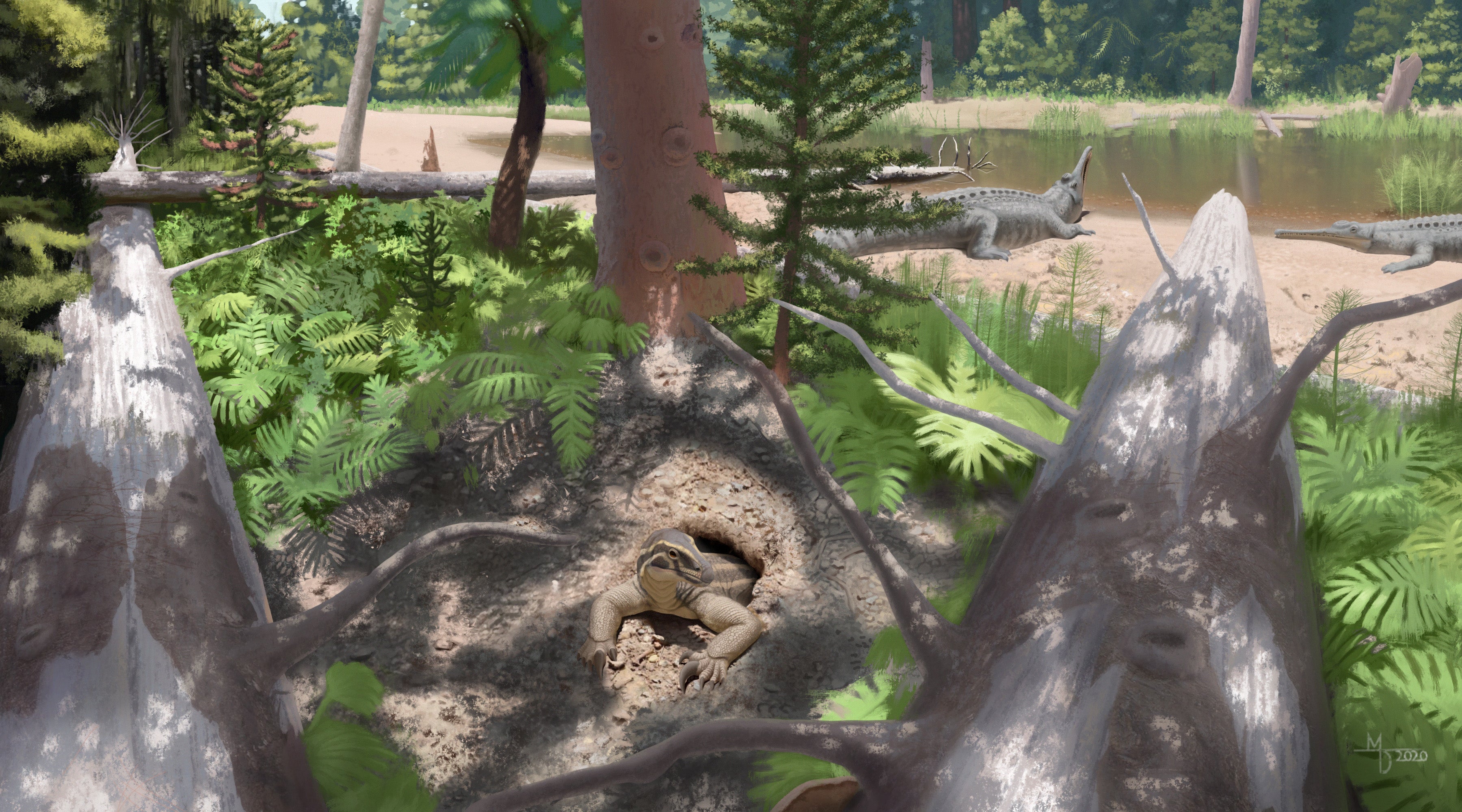Digging into claws: ASU student helps discover the fossil of a new dinosaur-like species

Xavier Jenkins holding coprolite (fossilized dung) at Thunderstorm Ridge, Petrified Forest National Park in 2019. Photograph courtesy of Xavier Jenkins.
Xavier Jenkins’ alarm goes off at 5:30 a.m. on a Saturday morning. The Arizona State University student and his roommate Ben Kligman quickly get ready and head to the dining hall to stock up on essential supplies for the day — granola bars, lunch meat, four liters of water and most importantly, black coffee. Along with other interns, they stop by the paleontology lab to pack their field gear — hand tools, plaster and other excavation equipment.
There are seven people headed to the dig site. It’s almost an hourlong car ride along a dirt road to their destination: Thunderstorm Ridge, located in Petrified National Forest. This fossil excavation site was discovered a few years ago. Made up of soft gray dirt and rocks, it’s rich in tiny micro invertebrate fossils that lived in a tropical or semitropical climate approximately 220 million years ago.
The interns, researchers and park staff spend the whole day out in the field, gathering material to be analyzed the same day at the on-site lab. Jenkins appreciates the rarity of this luxury, noting how paleontologists often wait weeks or even months to properly process their field material.
Back at the lab, Kligman and Jenkins work together analyzing what was brought in from the field. At Thunderstorm Ridge, they collect sections of rock and sediment, because many fossils are too small to see with the naked eye. Jenkins analyzes the material under a microscope.
Kligman excitedly rushes over to show Jenkins a “big” claw mixed in with the material brought in from the field. The 2-centimeter claw is larger than most fossils found at this site — even bigger than jawbones of some of the other species uncovered at Thunderstorm Ridge.
Equipped with a solid understanding of dinosaur bones, both Jenkins and Kligman knew instantly that this claw belonged to a member of the drepanosaurid family, but they didn’t know it belonged to a previously undiscovered species.
Jenkins had helped discover this new species of dinosaur-like creature. The species is now called Skybalonyx skapter and was small, about a foot long, with a special claw that distinguishes it from other species in the drepanosaurid family. The discovery and analysis was published in October in the Journal of Vertebrate Paleontology.
Jenkins graduated from ASU in May 2020, with Bachelor of Science degrees in anthropology from the School of Human Evolution and Social Change and biological sciences from the School of Life Sciences. The summer after his junior year, Jenkins completed a 12-week paleontology internship at Petrified Forest National Park.
“Even though living on-site was pretty isolating, almost every week a new university came in to conduct research,” Jenkins said. “Big-name paleontology professors visited to work on their own research, and I could help them and network the entire time.”

Field crew excavating at Thunderstorm Ridge, Petrified Forest National Park in 2019. Photograph courtesy of Xavier Jenkins.
The research continued
Petrified Forest paleontologists told Jenkins the newly discovered creature was obviously burrowing, because of the shape of the claw and other fossils identified at the site. But Jenkins wanted to better understand how and why the Skybalonyx skapter would have been a burrowing species, because other members of the drepanosaurid family have been classified as tree-climbing.
The Skybalonyx skapter had a special claw. In scientific terms, it’s called a disarticulated manual ungual. Jenkins wanted to compare the Skybalonyx skapter claw to the claws of different animals alive today.
Having worked previously in the lab with School of Human Evolution and Social Change President’s Professor Kaye Reed, Jenkins approached her with an idea to gather comparative data. Reed helped secure undergraduate research funding to send Jenkins to Washington, D.C., to conduct the research.
Jenkins visited bone collections at the Museum of Comparative Zoology at Harvard University and the Smithsonian to measure the claws of almost 200 species, including squirrels, chameleons and sloths. He measured the width, length and height of claws from reptiles and mammals, and creatures that climbed trees, dug burrows and lived underground.
The findings indicated that Skybalonyx skapter’s special claw most closely resembled the claws of burrowing animals like echidnas, moles and tortoises.
“Xavier developed this research on his own — he outlined the project and we discussed methodologies,” Reed said. “It was so exciting when he ran the multivariate analysis and categorized groups of animals based on how they used their manual digits. Xavier was tenacious throughout the process, and an exemplary undergraduate student. He’s going to be an excellent paleontologist.”
Artist Midiaou Diallo’s depiction of Skybalonyx skapter emerging from a burrow.
A young start in paleontology
“I was raised on dinosaur books,” Jenkins said. “My parents fed me Richard Dawkins' biology books since I was a kid, because that's what I expressed interest in, and I've been following that path ever since then.”
Through high school and undergraduate studies at ASU, Jenkins was ambitious, seeking out opportunities to learn more about studying dinosaurs as a career. He participated in fieldwork during high school, attended a vertebrate paleontology conference, helped faculty with lab research during college and was a member of ASU’s Undergraduate Anthropology Association.
“I didn't know what I wanted to do in paleontology, but I knew I wanted to be out there, digging,” Jenkins said.
Advice to current students
Jenkins took advantage of unique opportunities available at ASU. “I'm a strong proponent of undergraduate research,” Jenkins said. “This research wouldn’t have been possible if not for working in Kaye Reed’s lab. I also worked in Curtis Marean's lab for a year and that was great.”
Working in these labs was not a part of a posted internship. Instead, Jenkins simply asked if they needed help. He had already secured their permission to take graduate-level courses as an undergraduate student.
To students worried about reaching out to a professor, Jenkins recommends just asking. “Professors are people too,” he said. “And they're often doing such prolific work — especially at (the School of Human Evolution and Social Change). They can be on dozens of research projects and could use your help for something.”
What’s next
Jenkins is now working toward a PhD in biological sciences at another prestigious university. After earning a doctorate, he would like to go straight into a postdoc program, and someday have his own research lab as a tenured professor.
He wants to continue to examine the role of specific dinosaurs as individuals within an ecosystem. This study can be described as paleoecology. “I think it's great to find new species and describe them,” Jenkins said. "But if you're not understanding what they were actually doing, because they were living and breathing animals, what's the point?”
More Science and technology

ASU and Deca Technologies selected to lead $100M SHIELD USA project to strengthen U.S. semiconductor packaging capabilities
The National Institute of Standards and Technology — part of the U.S. Department of Commerce — announced today that it plans to…

From food crops to cancer clinics: Lessons in extermination resistance
Just as crop-devouring insects evolve to resist pesticides, cancer cells can increase their lethality by developing resistance to…

ASU professor wins NIH Director’s New Innovator Award for research linking gene function to brain structure
Life experiences alter us in many ways, including how we act and our mental and physical health. What we go through can even…
